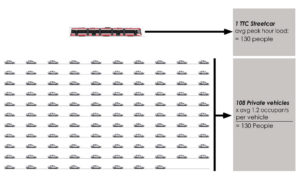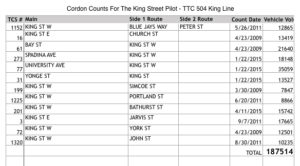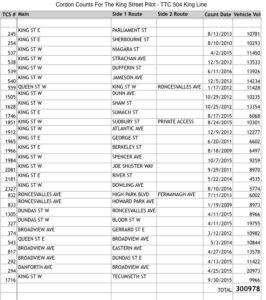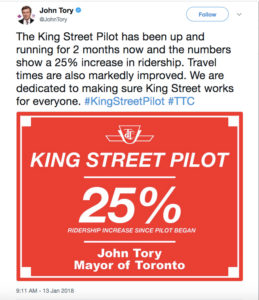
Unfortunately, the 3:1 ratio was absolutely necessary for former Chief City Planner Jennifer Keesmaat and Mayor John Tory to sell the public on the idea of the King Street Pilot Project. Had the City stated that more vehicles traverse over the 504 King line during the day, and that at peak hours the ratio is closer to 1:1, the pilot never would have launched. The project, which has now added congestion on other routes, and added to commute times to drivers (who on average already have longer commute times) is also placing many businesses that line the corridor in jeopardy of closing. To put things in perspective, many unforgiving, unsympathetic transit riders would rather see a .4 minute reduction in their morning commute than give any notice to the sous chef whose job is in peril.
The obstinance behind this project has everything to do with votes, and nothing to do with improving traffic congestion, or the city as a whole. The citizens of Toronto should be demanding more from their municipality, for ideas that benefit the majority and not for a single agenda. If changes to the 504 route were needed, the discussion should have been honest and not plied by manipulating perception; honest representation will lead to honest solutions. There are ways to conduct pilot projects with less reckless abandon, that can reduce collateral damage to traffic and communities. Where are the intellectuals who can construct well-balanced proposals regarding traffic, ones that don’t include having to artificially “animate” the affected area as an attempt to salvage losses?
Nevertheless, the issue about the ratio of transit passengers to vehicle counts has everything to do about executing projects with transparency and not with deception. The discussion about the project is moot once you acknowledge that the City misled its citizens, while negotiations to make adjustments merely distract from their original sin.
Below are lists of vehicle cordon counts provided by the City:



So, let’s analyze that 20K number of vehicles along this stretch. Note, the stretch includes King Street, Broadview and Roncesvalles, with approximately 100 points for cars to enter along 14 kms to be regarded as an “on” in the same way the TTC tabulates their counts of passengers; the second a vehicle turns onto any portion of the 504 King line––no matter where they disembark––it has to be counted as an “on”. In this regard, you’ll be able to legitimately compare (and the only way) to the 65K transit count that the City expounds to the public. The cordon counts provided by the City along this stretch includes 40 intersections, and the 8hr total exceeds 480,000 vehicles counted. Now, one still has to understand that there’s a likelihood of vehicles repeating in such counts, thus a simple addition of these counts would be inaccurate. However, what percentage of this count would be the appropriate theoretical number to exclude from the total? That said, to go from 480,000 to 20,000 is an extreme consideration of vehicle repetition along such a distance of road that covers diverse communities (commercial, residential, etc.) where much of that traffic is localized; that is to say, in order to reach 20K from 480,000, the City has excluded an enormous percentage of the total count! Ergo, 20,000 vehicles appears, even to the untrained eye, as completely arbitrary.
If that isn’t convincing enough, taken further—and to be more precise for all those conservatives out there—the cordon counts (when halved for the 504 corridor to reflect an avg. of vehicles passing through), still total to an enormous and staggering 244,000+ vehicles—light-years from the pilot’s proposal of 20,000. Still, one would then have to adjust for a full-day count and passengers, increasing the gap even further; at this point, even here, the distance from the City’s 20,000 claim reaches galactic proportions.
Any and all further iterations (due to the City’s lack of sufficient vehicle data) that one could possibly conceive to reduce vehicle numbers like a sauce of data, will never prove the City’s claim of 20,000 vehicles because the numbers are already so egregiously high—to defend them would speak to a shameful and indefensible bias against what is irrefutable evidence.
The biggest issue is that the City failed to do a proper assessment for vehicles with passengers. Negligence of this kind suggests the confusion that some unfortunately still, and remarkably, might have with regards to the disparity. A proper all-day vehicle count would also have to include a proper count of passengers along the 504 line; a passenger count that could be anywhere from 1.2 – 1.6 (or any arbitrary figure), since the City never made proper counts for the zones outside the pilot zone, and more importantly, to include them.
Halving cordon counts to gain a better average of vehicle traffic becomes irrelevant if one chooses to not include these all-day counts and passengers, as all would be needed to encompass a more exact figure; and that figure could theoretically be even larger than 480,000. And whatever the iteration of data, the number of vehicles and their passengers in an all-day count would irrefutably dwarf the 20,000 claim. The vehicle numbers are so high, they can only be ignored by the uninitiated; the proposal lacking adequate proportion, the original 20,000 claim can only be defended by the uninformed or those burdened by personal agenda.
The City’s failure to make a clear comparison from the start brings their non-calculations to the fore. It’s astonishing, if not embarrassing, that the City would make a comparison that cites approximately 14 kms of data for transit to something closer to 3 kms for vehicles.
The proposal is then evidently one-sided, biased, and more importantly, unscientific. Any iteration of data therefore is moot to the one point that matters: the City failed to make a proper comparison of vehicle passengers to transit passengers, one that confirms vehicle counts as higher in an all-day 14 km stretch.
It isn’t even close, and to ponder otherwise would be foolish. It almost isn’t worth the effort to spell out the obvious to those who choose to ignore an incredible discrepancy. However, in today’s world, one feels obligated to cater to each and every IQ bracket; otherwise, the simple premise of an article might escape a simple few detractors. Hopefully, the entire premise of this article will not elude the last few who might still be confused by the false comparison.
Not only is 20K unlikely, it’s impossible—a word one would normally use with reservation, but in this case it’s easy to be cavalier. Not only would one consider how localized the traffic is for each of these areas that would exclude any notion of such extreme repetition, these cordon counts only cover an 8 hr window, likely during the day, and perhaps in the evening. The false comparison gets worse, as vehicle traffic, particularly in the zone, would likely increase outside the 8hr window, where traffic in the entertainment district increases at night, as one would expect, and mostly to do with the passenger counts inside those vehicles (e.g. Uber, taxis, carpooling). The case only builds for vehicles and much of the data is either incomplete or being withheld since 20K is sadly not an accurate representation of the entire 504 line.

The recent claim of a 25% increase in ridership is again a highly suspicious statement by the TTC as they are not illustrating the hard data, and presenting the only positive claim from their most recent counts. 25% sounds lovely to the ear and looks wonderful in oversimplified graphs, but the 25% claim represents one intersection—one—at AM hours, and yet the public is led to believe it’s part of the whole. Note all the traffic data for private vehicles that are in the red, and there hasn’t been any significant changes for streetcar commutes at peak hours.

This project should not devolve into a “war on cars” debate, and the only issue should be about holding municipality accountable on their claims, expecting every citizen to demand the same from any form of government. To see this issue reduced to identity politics on the basis of this anti-car, Ford Nation narrative, is shameful of a supposed world-class city. This should no longer be about the merits or lack thereof about the project, this is about whether the pilot should have even launched in the first place. The data suggests that it shouldn’t have as it appears that private vehicles outnumber transit passengers by some distance. Ultimately, what is most questionable, even more than the design decisions of a few city planners, is the “integrity” of the data.
Of course, if businesses shut down and retail becomes less desirable, the likelihood of selling commercial real estate becomes more a possibility. This would benefit developers who eagerly await the possibility of purchasing real estate for future condo developments; benefits that can total into the hundreds of millions––the sums of which dwarf the losses associated with the diminished vibrancy of a neighbourhood and the viability for profitable retail leases. Reduced pedestrian traffic has made it difficult for the current businesses to survive and current residents should consider that the current “cool” factor of these areas will be washed away, and likely supplanted by retail chains. For those who don’t know, working at a bakery is not easy work, and they’re an enormous gift basket to any neighbourhood. Forno Cultura is one such offering on the strip, employing many hardworking people, and it would be a loss to the area if they were to go. Residents should beware as Moneris numbers don’t lie, and they can expect one of their favourite locals to disappear. Be careful what you wish for, King West.
——-
UPDATE: Although unnecessary to the point of the article, it now includes a furthered reduction of data for vehicles, which should dispel any doubt for the remaining few who think that the proposal was even remotely correct, proving even more concretely the entire premise of the article; detailing why 20,000 vehicles as represented by Transportation Services in their proposal to council was absolutely false.
To the above point, despite halving cordon counts, the vehicle counts still exclude a more exact figure for passenger counts and an all-day count comparable to the 504 streetcar which would increase the vehicle count significantly. Whatever combination of data used, (with or without these figures) it becomes irrelevant to the point of the article which proves that the city made a completely erroneous comparison.

